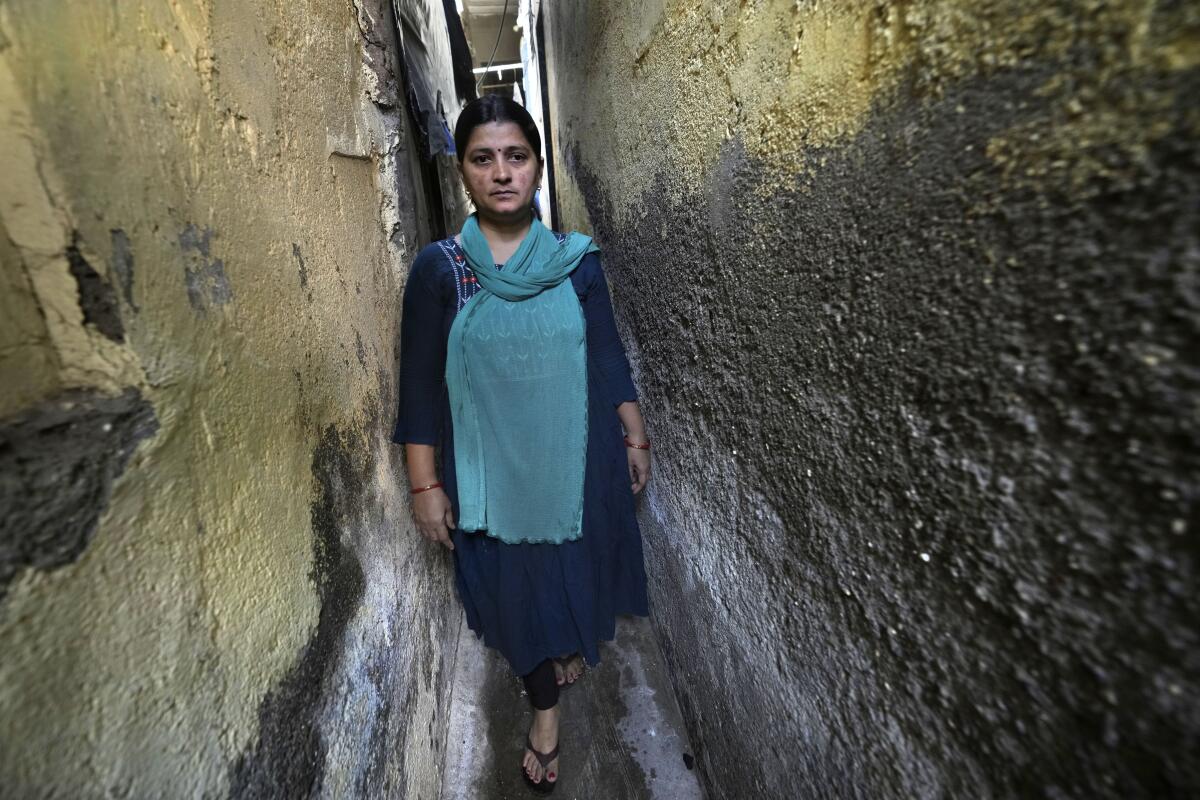As India’s population soars above all other nations, fewer women have jobs

- Share via
MUMBAI — Sheela Singh cried the day she handed in her resignation.
For 16 years, she had been a social worker in Mumbai, India’s frenetic financial capital, and she loved the work. But her family kept telling her she needed to stay home to take care of her two children. She resisted the pressure for years, but when she found out her daughter was skipping school, it felt as though she didn’t have a choice.
“Everyone used to tell me my kids were neglected. … It made me feel really bad,” Singh, 39, said.
When she resigned in 2020, Singh was earning more money than her husband, an auto rickshaw driver whose earnings fluctuated day to day. But nobody suggested he quit.
“His friends used to taunt him that he was living off my salary,” Singh said. “I thought that clearly there was no value in me working, so what’s the use?”
India is on the cusp of surpassing China to become the world’s most populous country, and its economy is among the fastest-growing in the world. But the number of Indian women in the workforce, already among the 20 lowest in the world, has been shrinking for years.
It’s not only a problem for women like Singh, but also a challenge for India’s own economic ambitions if its estimated 670 million women are left behind. The hope is that India’s fast-growing working-age population will propel its economy for years to come. Yet experts worry this could just as easily become a demographic liability if India fails to ensure high employment, especially among women.
Demographers are unsure exactly when India will take the title as the most populous nation in the world because they’re relying on estimates.
Without Singh’s income, her family can no longer afford to live in Mumbai, one of Asia’s most expensive cities, and she’s preparing to move back to her village to save money. “But there are no jobs there,” she said with a sigh.
The women’s employment rate peaked at 35% in 2004 and fell to about 25% in 2022, according to calculations based on official data, said Rosa Abraham, an economist at Azim Premji University. But official employment figures count people who report as little as one hour of work outside the home in the previous week.
A national jobs crisis is one reason for the gap, experts say, but entrenched cultural beliefs that see women as the primary caregivers and stigmatize them working outside the home, as in Singh’s case, are another.
The Center for Monitoring the Indian Economy, which uses a more restrictive definition of employment, found that only 10% of working-age women in 2022 were either employed or looking for jobs. This means there are only 39 million women employed in the workforce, compared with 361 million men.
Just a few decades ago, things seemed to be on a different track.
When Singh became a social worker in 2004, India was still riding high from historic reforms in the 1990s. Industries and opportunities were born seemingly overnight, sparking millions to leave their villages and move to cities such as Mumbai in search of better jobs.
It felt life-changing. “I didn’t have a college degree, so I never thought it would be possible for someone like me to get a job in an office,” she said.
India has long been home to online scammers targeting victims in far richer nations such as the United States. Now India is itself a target.
Even then, leaving home to work was an uphill fight for many women. Sunita Sutar, who was in school in 2004, said that women in her village of Shiraswadi in Maharashtra state were usually married off at 18, beginning lives that revolved around their husbands’ homes. Neighbors mocked her parents for investing in her education, saying it wouldn’t matter after marriage.
Sutar bucked the trend. In 2013, she became the first person in her village of nearly 2,000 people to earn an engineering degree.
“I knew that if I studied, only then would I become something; otherwise, I’d be like the rest, married off and stuck in the village,” Sutar said.
Today, she lives and works in Mumbai as an auditor for the Defense Ministry, a government job coveted by many Indians for its security, prestige and benefits.
In one way, she was part of a trend: Indian women have gained better access to education since her youth and are now nearly at parity with men. But for most women, education hasn’t led to jobs. Even as more women have begun graduating from school, joblessness has swelled.
“The working-age population continues to grow, but employment hasn’t kept up, which means the proportion of people with jobs will only decline,” said Mahesh Vyas, director at the Center for Monitoring the Indian Economy, adding there’s been a severe slowdown in good quality jobs in the last decade. “This also keeps women out of the workforce as they or their families may see more benefit in taking care of the home or children, instead of toiling in low-paid work.”
And even when jobs are available, social pressures can keep women away.
In her home village in Uttar Pradesh state, Lalmani Chauhan hardly ever saw women working outside the home. But when she came to Mumbai in 2006, she saw women swarm public spaces, Chauhan said, serving food in cafes, cutting hair or painting nails in salons, selling tickets for the local trains, or boarding the trains themselves, crammed into packed compartments as they rushed to work. It was motivating to see what was possible, she said.
Vice President Kamala Harris administers the oath of office to the former L.A. mayor, who fought for his new job for nearly two years.
“When I started working and leaving the house, my family used to say I must be working as a prostitute,” said Chauhan, a social worker.
One reason she was able to hold on to her job was that it became a lifeline when an accident left her husband bedridden and unable to work, Chauhan said.
Abraham said there is growing recognition among policymakers that the retreat of women from the workforce is a huge problem, but that it has not been met with direct fixes such as more child-care facilities or transportation safety.
When more women participate in the labor market, she said, they contribute to the economy and their family’s income, but they also are empowered to make decisions. Children who grow up in a household where both parents work, especially girls, are more likely to be employed later.
The number of working-age Indian women who don’t have jobs is staggering — almost twice the entire number of people in the United States. Experts say this gap could be a huge opportunity if India can find a way to plug it. A 2018 McKinsey report estimated that India could add $552 billion to its gross domestic product by increasing its female workforce participation rate by 10%.
Even as she prepares to leave her one-bedroom home, tucked deep inside a narrow lane in a Mumbai slum, Singh is determined to return to the city in the near future. She hopes to find a way to work again, saying she will take whatever job she can find.
“I never had to ask anyone for a single rupee” before, Singh said, adding she feels shame every time she’s forced to ask her husband.
“I felt independent before. See, I lost a part of myself when I quit my job,” she said. “I want that feeling back.”
More to Read
Sign up for Essential California
The most important California stories and recommendations in your inbox every morning.
You may occasionally receive promotional content from the Los Angeles Times.
















